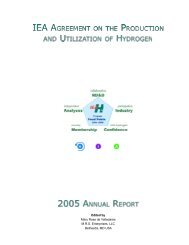Technology Status of Hydrogen Road Vehicles
Technology Status of Hydrogen Road Vehicles
Technology Status of Hydrogen Road Vehicles
Create successful ePaper yourself
Turn your PDF publications into a flip-book with our unique Google optimized e-Paper software.
! Take cryogenic precautions.<br />
! Detect, control, and extinguish fires.<br />
! Identify and assess hazards.<br />
Linney (1996) is a study <strong>of</strong> quantified risk assessment techniques in optimizing the safety features <strong>of</strong> on-board<br />
hydrogen systems. One important conclusion is that, in many real hydrogen leak scenarios, high release<br />
velocities and normal ambient winds overshadow the buoyancy/diffusivity advantages.<br />
A1.3 Recent Safety Analysis and Integral Safety Testing for H 2 <strong>Vehicles</strong><br />
For illustration, three projects will be reviewed from which we can extract relevant safety information:<br />
! MAN full-size city bus fueled with LH 2, and now ready for public demonstration<br />
! BMW integral testing in severe accidents with LH 2 tanks<br />
! Urban LH 2 refueling station.<br />
(On-board GH 2 and metal hydride storage is discussed in section A1.3.4.)<br />
A1.3.1 Safety Analysis for MAN LH 2 City Bus<br />
This bus is identified as item 3 in Table 1, which compares the characteristics and performance, if available,<br />
<strong>of</strong> ongoing demonstrations <strong>of</strong> H 2 vehicles.<br />
The LH 2 bus is a modified MAN 6-cylinder, 12-liter, natural gas engine, able to develop 140 kW maximum<br />
on H 2 with 8:1 compression ratio; external mixture formation with sequential multi-port injection. When full<br />
the three LH 2 cylinders, accommodated under the bus, contain about 40 kg <strong>of</strong> fuel, have a total weight <strong>of</strong> about<br />
300 kg and a volume <strong>of</strong> 630 liters; they suffer 6% boil-<strong>of</strong>f per day. Ninety-two passengers can be carried in<br />
urban service with a range <strong>of</strong> 250 km.<br />
MAN engineers have carried out a fairly detailed risk assessment for this bus, in the form <strong>of</strong> a Hazops study<br />
(a hazards and operation analysis), in which engineering judgment substitutes, to some extent, the detailed<br />
statistics needed for a full-blown probabilistic risk assessment. The Hazops study was carried out in<br />
collaboration with the regulatory authority <strong>of</strong> Bavaria on the accident scenarios and the countermeasures<br />
needed to guarantee safety.<br />
This approach, based on engineering judgment <strong>of</strong> possible accident initiators and their development in the<br />
system, was then extended to a worst-case scenario in which logic and engineering judgment are put aside,<br />
and an accident scenario is maximized to identify extreme countermeasures. This scenario is intended to<br />
answer the severest critics <strong>of</strong> the system’s safety.<br />
The worst case imagined was the rupture <strong>of</strong> a single tank filled with LH 2.<br />
A1.3.2 BMW Simulations <strong>of</strong> Severe Accidents with LH 2 Tanks<br />
In the absence <strong>of</strong> probabilistic risk assessments, or <strong>of</strong> the more simplified Hazops studies, an approach <strong>of</strong>ten<br />
taken to accident analysis is to identify a series <strong>of</strong> worst-case scenarios, in which the originating cause <strong>of</strong> an<br />
accident and its logical progression are ignored, and attention is focused on its ultimate consequences.<br />
The tools used can be analytical, if enough differential data are available; more <strong>of</strong>ten with a new technology,<br />
an experimental approach is adopted whereby the ultimate event is simulated and the consequences observed<br />
on the component or system. Thus BMW has taken LH 2 tanks <strong>of</strong> the suppliers Linde and Messer Griesheim,<br />
28













